

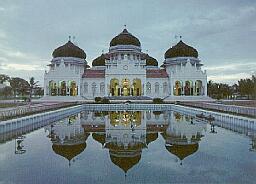 For the New Year I was in Indonesia at Tuk Tuk on
Samosir Island in Lake Toba, Sumatra. Shortly after the New Year I traveled back to Medan
and then caught an over night bus up to Banda Aceh on the extreme northern coast of
Sumatra. The Aceh province had a more extreme form of Islam than the rest of Indonesia and
generally wanted its independence from the rule of Jakarta. Banda Aceh had a beautiful
central mosque and a colorful central market, however, I had really traveled up to the
province to go out to the island called Pulau Weh. From Banda Aceh's port of Krueng Raja
it was a 2.5 hour sailing out to the idyllic tropical island which was famous for it's
marine national park and diving.
For the New Year I was in Indonesia at Tuk Tuk on
Samosir Island in Lake Toba, Sumatra. Shortly after the New Year I traveled back to Medan
and then caught an over night bus up to Banda Aceh on the extreme northern coast of
Sumatra. The Aceh province had a more extreme form of Islam than the rest of Indonesia and
generally wanted its independence from the rule of Jakarta. Banda Aceh had a beautiful
central mosque and a colorful central market, however, I had really traveled up to the
province to go out to the island called Pulau Weh. From Banda Aceh's port of Krueng Raja
it was a 2.5 hour sailing out to the idyllic tropical island which was famous for it's
marine national park and diving.
On Pulau Weh I hitched across the island to the small village of Iboih. In Iboih I stayed in a hill side cabin overlooking the sea, the palm fringed beach and Rubiah Island. The cabin was built up on stilts and was very basic, but it had a great deck with a spectacular view. We hired snorkels, masks and fins and went snorkeling over the reef in the marine national park around Rubiah Island. I saw a great variety of sea life including Sting Ray, Manta Ray, Moray Eel, turtles, sea snakes, Scorpion Fish and a large variety of beautifully colored tropical fish. While on the island I met up with a Dutch group who wanted to do a trip down through the Gunung Leuser National Park. I had wanted to do this journey for a while but had not been able to find any travel companions, so now I was set.
We all caught the ferry back to Banda Aceh and then began our journey into the more remote interior of northern Sumatra. The first leg of the trip was an eight hour bus journey up into the Bukit Barisan mountains to Takengon on Lake Tawar. Takengon was a friendly little town with a comfortable climate since we were at an altitude of 1000m. We spent a few days based in the town doing treks around the lake, and a trip out to the village of Bintang and the hot springs at Simpang Beliq.
 From Takengon it was a 10 hour journey down to
Blankejeren, so we decided to break the journey in half and get off the bus in the tiny
hamlet of Ise Ise. It was a beautiful location with a fast running river and dense
rainforest all around. The bus pulled away and we eagerly looked for somewhere to stay.
There was a reasonable looking losman, but strangely they said they were full even though
it was obvious that they weren't. After a short while we realized why - the place was a
brothel for a nearby military camp! Eventually I managed to negotiate with one of
villagers for us to stay with them - we had little choice since the next bus out of Ise
Ise was the following day. I was thankful that my Indonesian was up to it, otherwise we
might have been sleeping rough for the night. One of the guys in the village had a baby
Orangutan who seemed to think that I was it's father - I put it down to my coloring. Of
course it was strictly illegal for people to keep baby Orangutans for pets, but Ise Ise
didn't seem to need to abide by many of the rules.
From Takengon it was a 10 hour journey down to
Blankejeren, so we decided to break the journey in half and get off the bus in the tiny
hamlet of Ise Ise. It was a beautiful location with a fast running river and dense
rainforest all around. The bus pulled away and we eagerly looked for somewhere to stay.
There was a reasonable looking losman, but strangely they said they were full even though
it was obvious that they weren't. After a short while we realized why - the place was a
brothel for a nearby military camp! Eventually I managed to negotiate with one of
villagers for us to stay with them - we had little choice since the next bus out of Ise
Ise was the following day. I was thankful that my Indonesian was up to it, otherwise we
might have been sleeping rough for the night. One of the guys in the village had a baby
Orangutan who seemed to think that I was it's father - I put it down to my coloring. Of
course it was strictly illegal for people to keep baby Orangutans for pets, but Ise Ise
didn't seem to need to abide by many of the rules.
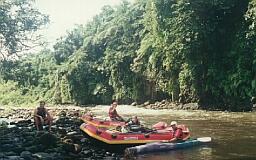 After a couple of days we managed to get a ride out
of Ise Ise and travel down to Blankejeren and on to Ketembe, where we wanted to organize a
rafting trip on the Alas river. After a good deal of negotiating I managed to arrange an
all inclusive 5 day rafting trip for US$60 per person, which was a good deal. The trip
would take us down the Alas river through the huge Gunung Leuser National Park. Our
guides, although very friendly, didn't seem to have much experience and on the first big
rapid two of us were thrown out of the raft! A couple of nights we slept out under the
stars on gravel beaches and for the other nights we slept in a tree houses, The scenery
was magical varying from wide meandering sections of the river to canyons with class IV
rapids, and all the time flanked by lush rainforest. Over the 5 days we traveled for
approximately 200km on the Alas river and managed to see a good deal of wildlife including
monkeys, snakes, bats, Hornbills, Kingfishers, and beautiful butterflies.
After a couple of days we managed to get a ride out
of Ise Ise and travel down to Blankejeren and on to Ketembe, where we wanted to organize a
rafting trip on the Alas river. After a good deal of negotiating I managed to arrange an
all inclusive 5 day rafting trip for US$60 per person, which was a good deal. The trip
would take us down the Alas river through the huge Gunung Leuser National Park. Our
guides, although very friendly, didn't seem to have much experience and on the first big
rapid two of us were thrown out of the raft! A couple of nights we slept out under the
stars on gravel beaches and for the other nights we slept in a tree houses, The scenery
was magical varying from wide meandering sections of the river to canyons with class IV
rapids, and all the time flanked by lush rainforest. Over the 5 days we traveled for
approximately 200km on the Alas river and managed to see a good deal of wildlife including
monkeys, snakes, bats, Hornbills, Kingfishers, and beautiful butterflies.
After the Alas river trip I found myself approaching the end of my third 2 month Indonesian visa, so it was time to head back to Singapore. I traveled back down to Batusangkar and said my final good-byes, before returning to Singapore via Pekanbaru.
 I arrived back in Singapore on 2nd February and
returned to my normal guesthouse - Lee's Travelers Club on Beach Road. The following day I
did my usual run to the American Express office to pick up my mail. I had a letter from my
mother, brother and best mate Mark. There was also a hand written note attached to my
bundle of letters - the message was to abruptly end my trip - it read "Gavin - Your
father has passed away in England". Although my father hadn't been in the best of
health this was a total surprise. I spend the next couple of days arranging my flight back
to England.
I arrived back in Singapore on 2nd February and
returned to my normal guesthouse - Lee's Travelers Club on Beach Road. The following day I
did my usual run to the American Express office to pick up my mail. I had a letter from my
mother, brother and best mate Mark. There was also a hand written note attached to my
bundle of letters - the message was to abruptly end my trip - it read "Gavin - Your
father has passed away in England". Although my father hadn't been in the best of
health this was a total surprise. I spend the next couple of days arranging my flight back
to England.
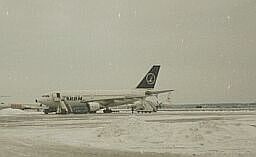 On 6th February I caught my Cathy Pacific flight up
to Bangkok and then my Tarom (Romanian airline) flight to London via Bucharest. I arrived
in Bucharest at 6.00am the next morning and it was -10 Celsius, quite a shock since it had
been 30 Celsius in Singapore and now we had to walk through the snow to the airport
shuttle bus! I finally arrived back at Heathrow in London at 11.30 on 7th February and
then traveled home by train.
On 6th February I caught my Cathy Pacific flight up
to Bangkok and then my Tarom (Romanian airline) flight to London via Bucharest. I arrived
in Bucharest at 6.00am the next morning and it was -10 Celsius, quite a shock since it had
been 30 Celsius in Singapore and now we had to walk through the snow to the airport
shuttle bus! I finally arrived back at Heathrow in London at 11.30 on 7th February and
then traveled home by train.
On 19th May I resumed my trip by catching a direct 12 hour flight from London to Tokyo. I planned to explore Japan for a couple of months and also to visit my best mate, Mark, who was working in Tokyo. Due to my traveling and his working in Japan I hadn't seen Mark for 20 months, so we had allot of catching up to do. Mark met me at Narita airport and we caught the JR train back to Shimosa Nakayama where he was living.
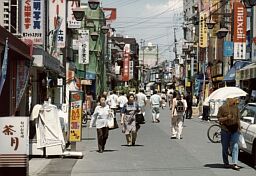
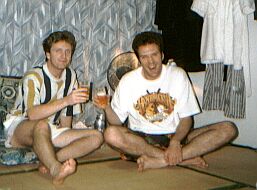 Mark's suburb seemed a lively little place
with a busy main street lined with restaurants and stores of every kind. It was about 30
minutes on the local Sobu line commuter train in to the the heart of Tokyo. The house was
typically Japanese with a tatami mat living room, a futon for the bed, a Japanese style
bathroom and built mainly of wood. The bath was certainly different as you filled it
with cold water and then put the bath's gas heater on to bring it up to temperature,
finally you sat upright in it!
Mark's suburb seemed a lively little place
with a busy main street lined with restaurants and stores of every kind. It was about 30
minutes on the local Sobu line commuter train in to the the heart of Tokyo. The house was
typically Japanese with a tatami mat living room, a futon for the bed, a Japanese style
bathroom and built mainly of wood. The bath was certainly different as you filled it
with cold water and then put the bath's gas heater on to bring it up to temperature,
finally you sat upright in it!
I spent a good couple of weeks living in Mark's house and exploring Tokyo. I had a fun time visiting the various skyscrapers, checking out the stores, negotiating the awesome mass transit system and people watching. The huge Shinjuku railway station has to be seen to be believed with up to 2 million people passing through it every day. Skinjuku together with Tokyo station are two of the busiest and most complicated railway stations in the world. The rush hour on the subway was just as I had seen on TV, with staff employed to push people into the carriages - certainly not for the claustrophobic!
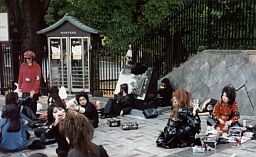 We visited Ginza, the famous ritzy shopping
district, did some window shopping and then checked out the latest products on show in the
Sony building. Of course we had to have High Tea in the well known Twinings Tea Salon.
Looking down on the busy Sukiyabasi crossing I got a real feel for the density of people
living and working in this huge city. One Sunday we visited Harajuku where the young
trendies seemed to congregate, and Yoyogi-Koen park where we spotted the Elvis
look-a-likes and Punk Rockers.
We visited Ginza, the famous ritzy shopping
district, did some window shopping and then checked out the latest products on show in the
Sony building. Of course we had to have High Tea in the well known Twinings Tea Salon.
Looking down on the busy Sukiyabasi crossing I got a real feel for the density of people
living and working in this huge city. One Sunday we visited Harajuku where the young
trendies seemed to congregate, and Yoyogi-Koen park where we spotted the Elvis
look-a-likes and Punk Rockers.
 Mark and I visited the famous Meiji-jingu Shinto
shrine, which was located in and incredibly tranquil park in the center of Tokyo. The
shrine is reputedly one of the finest in all of Japan and was certainly very impressive.
At the entrance to the complex were gigantic torri gates of solid Cypress wood. Just by
coincidence there was a wedding ceremony going on, with the bride and groom in full
traditional dress - quite a treat to see. Mark also took me out for a night in the famous
night life area of Roppongi. The place was certainly buzzing but then so were the prices -
a few beers each later and we were US$100 worse off.
Mark and I visited the famous Meiji-jingu Shinto
shrine, which was located in and incredibly tranquil park in the center of Tokyo. The
shrine is reputedly one of the finest in all of Japan and was certainly very impressive.
At the entrance to the complex were gigantic torri gates of solid Cypress wood. Just by
coincidence there was a wedding ceremony going on, with the bride and groom in full
traditional dress - quite a treat to see. Mark also took me out for a night in the famous
night life area of Roppongi. The place was certainly buzzing but then so were the prices -
a few beers each later and we were US$100 worse off.
I worked out that the only way I could really afford to see Japan was to buy one of the 3 week JR rail passes and to travel like crazy for three weeks. The rail pass cost around US$500 but allowed unlimited travel on the whole JR network, including the Shinkansen (Bullet Train). On 5th June I began my three week whirlwind tour of Japan. I caught the local commuter train into Tokyo and then boarded the 10.07 Hikari Super Express Shinkansen to Hakata on the island of Kyushu. We covered the 1,200km in just over 6 hours, averaging a speed of around 200km per hour. I thought of how expensive it must have been to build the Shinkansen as for much of the journey we were traveling on high viaducts or through long tunnels. Once in Hakata I transferred to a normal train to Dazaifu, which was to be my first stop.
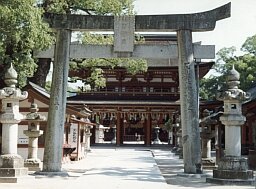 In Dazaifu I stayed at the local youth hostel which
was supposed to be a temple, however, I couldn't see much evidence of this. It was US$30 a
night, but I did get a nice room with tatami mat flooring. I had a good nights sleep and
came down to a typical Japanese breakfast of Miso soup, rice, pickles, tofu, pork
dumplings and a large slice of melon. After the breakfast experience I went to see the
beautiful Tenmangu shrine and gardens, and then I visited the Komyo-ji temple with it's
classic Zen garden. The all wooden Komyo-ji temple had beautiful tatami mat rooms with
traditional paper screens and hanging scrolls. In the center of the temple was a court
yard with a meticulously kept Zen garden. The Zen garden was particularly interesting in
the way the raked white pebbles represented the sea and the moss covered boulders the
land.
In Dazaifu I stayed at the local youth hostel which
was supposed to be a temple, however, I couldn't see much evidence of this. It was US$30 a
night, but I did get a nice room with tatami mat flooring. I had a good nights sleep and
came down to a typical Japanese breakfast of Miso soup, rice, pickles, tofu, pork
dumplings and a large slice of melon. After the breakfast experience I went to see the
beautiful Tenmangu shrine and gardens, and then I visited the Komyo-ji temple with it's
classic Zen garden. The all wooden Komyo-ji temple had beautiful tatami mat rooms with
traditional paper screens and hanging scrolls. In the center of the temple was a court
yard with a meticulously kept Zen garden. The Zen garden was particularly interesting in
the way the raked white pebbles represented the sea and the moss covered boulders the
land.
Next I visited Nagasaki and it's Atomic Bomb Museum. The museum was both fascinating and disturbing - as I am sure it was designed to be. After the museum I went to the Epi-Center Park where a black stone column marked the exact spot over which the 22 kiloton 'Fat Man' atomic bomb exploded. Everything within 1 km was totally destroyed and the resulting fire storm burnt out everything within a 4 km radius (a third of the city and 75,000 people were wiped out).
Next I traveled to Kumamoto where I visited the famous castle and the beautiful Suizenji-Koen garden. After Kumamoto it was on to Aso. I checked into the Aso youth hostel and then retired to the communal hot bath for a soak. When I came to leave the bath I found that all my clothes were gone and nobody seemed to speak English. Trying to explain my situation with sign language, while being totally naked, was certainly not the best way to put the locals at ease with foreigners! I spent a day trekking up Mt. Aso and then traveled to the spa town of Yufuin. Yufuin was a pleasant little rural town set among paddy fields and surrounded by wooded mountains. I found a lovely traditional rotemburo (open air hot spring) and spent a few hours soaking with the locals.
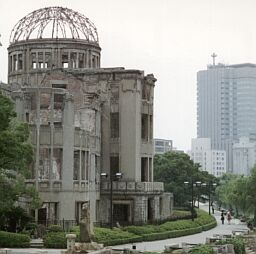 My next stop was the city of Hiroshima back on the
main island of Honshu. First I visited the Children's Peace Park which was set up in the
memory of a young girl who died of leukemia. In her dying days the girl had set herself
the challenge of folding a 1,000 paper cranes (the symbol of longevity and happiness), but
she died having completed only 644. The children of her school folded the remaining 356.
Nowadays the memorial is covered by perhaps a million paper cranes! After, I visited the
famous A Dome which was still standing despite being only 30m from the epi-center of the
atomic blast. Next I visited the Peace Flame that will apparently burn continuously until
the last nuclear weapon is destroyed. I also spent several hours in the Hiroshima Atomic
Bomb museum which was again totally fascinating.
My next stop was the city of Hiroshima back on the
main island of Honshu. First I visited the Children's Peace Park which was set up in the
memory of a young girl who died of leukemia. In her dying days the girl had set herself
the challenge of folding a 1,000 paper cranes (the symbol of longevity and happiness), but
she died having completed only 644. The children of her school folded the remaining 356.
Nowadays the memorial is covered by perhaps a million paper cranes! After, I visited the
famous A Dome which was still standing despite being only 30m from the epi-center of the
atomic blast. Next I visited the Peace Flame that will apparently burn continuously until
the last nuclear weapon is destroyed. I also spent several hours in the Hiroshima Atomic
Bomb museum which was again totally fascinating.
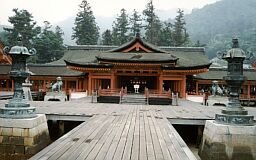 My next stop was the nearby island of Miyajima. The
island was quintessential Japanese with shrines, temples, ornate gardens, parks, wild
dear, mountains and the sea. I spent a very pleasant day strolling around the island and
visiting the various attractions including the famous Itsukushima-jinja shrine (Floating
Torri). Although there were many domestic tourists on the island, when I did the hike up
to the Mt. Misen peak (530m) I only saw a handful of people.
My next stop was the nearby island of Miyajima. The
island was quintessential Japanese with shrines, temples, ornate gardens, parks, wild
dear, mountains and the sea. I spent a very pleasant day strolling around the island and
visiting the various attractions including the famous Itsukushima-jinja shrine (Floating
Torri). Although there were many domestic tourists on the island, when I did the hike up
to the Mt. Misen peak (530m) I only saw a handful of people.
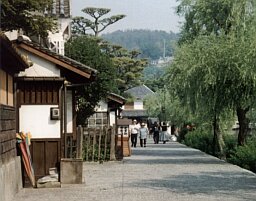 After Miyajima I left the Hiroshima area and
traveled east along Honshu to the town of Kurashiki. On the way I did a side trip over to
Shikoku, Japan's 4th largest island. The train took me across the new 15km long
Seto-ohashi bridge, which spans one of the prettiest sections of Japan's Inland Sea.
Kurashiki's main attraction was a quaint old area of black tiled warehouses set along an
old canal. The canal was flanked my Willow trees and most of the older buildings had been
converted to little restaurants and shops. When I arrived at the Kurashiki youth hostel I
discovered that I was the only guest staying at the 60 bed hostel and that they had opened
it up just for me!
After Miyajima I left the Hiroshima area and
traveled east along Honshu to the town of Kurashiki. On the way I did a side trip over to
Shikoku, Japan's 4th largest island. The train took me across the new 15km long
Seto-ohashi bridge, which spans one of the prettiest sections of Japan's Inland Sea.
Kurashiki's main attraction was a quaint old area of black tiled warehouses set along an
old canal. The canal was flanked my Willow trees and most of the older buildings had been
converted to little restaurants and shops. When I arrived at the Kurashiki youth hostel I
discovered that I was the only guest staying at the 60 bed hostel and that they had opened
it up just for me!
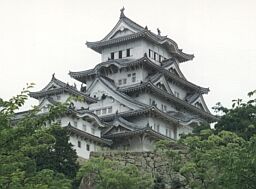 Next I traveled to Himeji, where I visited the
famous Himeji-jo castle. The castle is regarded as the most splendid original castle in
the whole of Japan and dates back to 1333, with the current construction dating from 1580.
The structure had a 5 story main donjon with three satellite donjons. The castle was
steeped in history, and as I walked around the dimly lit wooden corridors I could only
imagine what it must have been like to live in ancient Japan. The castle gardens were
equally impressive and served well for me little siesta that I had after my tour!
Next I traveled to Himeji, where I visited the
famous Himeji-jo castle. The castle is regarded as the most splendid original castle in
the whole of Japan and dates back to 1333, with the current construction dating from 1580.
The structure had a 5 story main donjon with three satellite donjons. The castle was
steeped in history, and as I walked around the dimly lit wooden corridors I could only
imagine what it must have been like to live in ancient Japan. The castle gardens were
equally impressive and served well for me little siesta that I had after my tour!

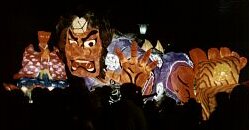 From Himeji I caught the Shinkansen to Osaka from
where I traveled to the holy town of Koya-san. From Osaka it was two local trains and then
a cable car up to the town of Koya-san, which was located on a thickly forested tableland
surrounded by eight peaks. I stayed in a small temple / ryokan, and had a traditional
Japanese style room which opened up onto a beautiful ornate garden. The other guests were
extremely friendly and despite them not speaking a word of English we seemed to have a
great time. After a delicious evening meal I joined the other guests who went out to see
the evening procession for the celebration of Kobo-Daichi's birthday. Kobo-Daichi had been
the priest who had established the Buddhist monastic complex that Koya-san was famous for.
The colorfully lit floats were quite a spectacle and I felt very lucky to have arrived on
such a special date.
From Himeji I caught the Shinkansen to Osaka from
where I traveled to the holy town of Koya-san. From Osaka it was two local trains and then
a cable car up to the town of Koya-san, which was located on a thickly forested tableland
surrounded by eight peaks. I stayed in a small temple / ryokan, and had a traditional
Japanese style room which opened up onto a beautiful ornate garden. The other guests were
extremely friendly and despite them not speaking a word of English we seemed to have a
great time. After a delicious evening meal I joined the other guests who went out to see
the evening procession for the celebration of Kobo-Daichi's birthday. Kobo-Daichi had been
the priest who had established the Buddhist monastic complex that Koya-san was famous for.
The colorfully lit floats were quite a spectacle and I felt very lucky to have arrived on
such a special date.
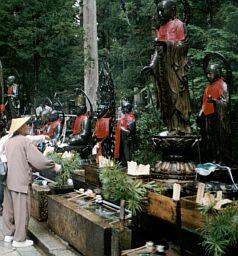
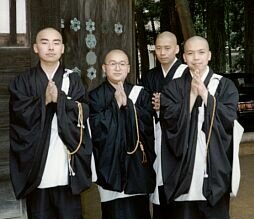 The following day my first visit was to the temple
of Okunoin, where Kobo-Daichi was enshrined. The path to the temple was through a dense
forest of huge old Cedar trees and was flanked by hundreds of old tombstones. The
tombstones were of the most important people in the history of Japan, including Emperors,
Shoguns, Samurai, warriors and priests etc. The main hall of the temple Toro-do (Lantern
Hall) housed thousands of burning lanterns and behind was the tomb of Kobo-Daichi. At the
tomb there were hundreds of pilgrims saying their prayers and lighting incense and
candles. I also visited the Garan (Sacred Precinct) where I saw the grand Kondo (Main
Hall) and Dai-to (Great Pagoda). At the Sacred Precinct I met a group of friendly monks
who could speak a bit of English, and seemed to enjoy showing me around.
The following day my first visit was to the temple
of Okunoin, where Kobo-Daichi was enshrined. The path to the temple was through a dense
forest of huge old Cedar trees and was flanked by hundreds of old tombstones. The
tombstones were of the most important people in the history of Japan, including Emperors,
Shoguns, Samurai, warriors and priests etc. The main hall of the temple Toro-do (Lantern
Hall) housed thousands of burning lanterns and behind was the tomb of Kobo-Daichi. At the
tomb there were hundreds of pilgrims saying their prayers and lighting incense and
candles. I also visited the Garan (Sacred Precinct) where I saw the grand Kondo (Main
Hall) and Dai-to (Great Pagoda). At the Sacred Precinct I met a group of friendly monks
who could speak a bit of English, and seemed to enjoy showing me around.
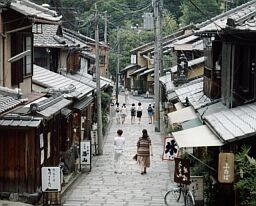 From Koya-san I traveled via Osaka to Kyoto, the
cultural capital of Japan. I arrived in the evening and quickly found a popular Gaijin
House (Foreigners House) in the downtown area. I spent three days exploring the many sight
of Kyoto, including the famous hillside temple of Kiyomizu-deca, the canal side walk
called 'The Path of Philosophy', the beautiful 'Leaping Tiger' Zen garden, the old wooden
houses of Sannen-zaka street and the quaint little teahouses of Ninnen-zaka street. One
evening after all of the sightseeing I decided to pay a visit to the local sento (public
bath). At the sento I stripped naked, as was the custom, and walked into the bathing area
for the men. Inside I was quite amazed to see a little old lady vacuuming around the naked
men! The sento was quite busy, but had 4 - 5 different baths and I spotted one bath that
was empty. I tested the water with my foot and as it was a nice temperature I waded in.
Suddenly my body jerked as electric currents were passed through me - I then figured out
why the bath was empty!
From Koya-san I traveled via Osaka to Kyoto, the
cultural capital of Japan. I arrived in the evening and quickly found a popular Gaijin
House (Foreigners House) in the downtown area. I spent three days exploring the many sight
of Kyoto, including the famous hillside temple of Kiyomizu-deca, the canal side walk
called 'The Path of Philosophy', the beautiful 'Leaping Tiger' Zen garden, the old wooden
houses of Sannen-zaka street and the quaint little teahouses of Ninnen-zaka street. One
evening after all of the sightseeing I decided to pay a visit to the local sento (public
bath). At the sento I stripped naked, as was the custom, and walked into the bathing area
for the men. Inside I was quite amazed to see a little old lady vacuuming around the naked
men! The sento was quite busy, but had 4 - 5 different baths and I spotted one bath that
was empty. I tested the water with my foot and as it was a nice temperature I waded in.
Suddenly my body jerked as electric currents were passed through me - I then figured out
why the bath was empty!
From Kyoto I traveled by Shinkansen right up through northern Honshu and across to Hokkaido, Japan's 2nd largest island. I spend a night in a friendly little minshiku (guesthouse) in Hakodate and then traveled up to the main city of Sapporo. Sapporo has the coveted reputation as having the best sushi in Japan and I certainly enjoyed checking it out. I particularly enjoyed some of the sushi bars that had the sushi on a conveyor belt, so that you could simply grab the plates of sushi you fancied as the went by!
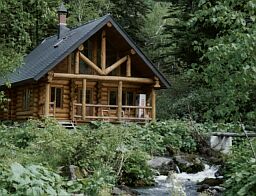
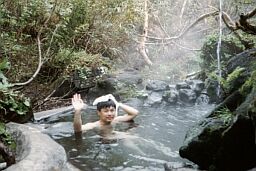 From Sapporo I traveled to the Daisetsuzan National
Park in the center of Hokkaido. I managed to stay in a lovely log cabin at the Asahidake
Onsen. Since it was low season I only had to share the large 4 bedroom cabin with one
other Japanese guy. Along a small path, some 50m behind the cabin, was a natural hot
spring in the forest that we could use at any time. It was great relaxing in the piping
hot water in the middle of the forest with patches of unmelted snow around us. I spend
four days at the onsen and did some challenging hikes. One day I set off for the Tenninkyo
Onsen and got completely lost in the forest which still had a thick layer of snow
obscuring the paths - luckily I had a map and compass so I managed to eventually find my
way. The following day I caught a cable car to the starting point for the trek up the
Asahidake volcano and then hiked to the summit. First I had to walk across a snow field
with roaring steam vents and then climb a rocky path up to the 2,290m peak.
From Sapporo I traveled to the Daisetsuzan National
Park in the center of Hokkaido. I managed to stay in a lovely log cabin at the Asahidake
Onsen. Since it was low season I only had to share the large 4 bedroom cabin with one
other Japanese guy. Along a small path, some 50m behind the cabin, was a natural hot
spring in the forest that we could use at any time. It was great relaxing in the piping
hot water in the middle of the forest with patches of unmelted snow around us. I spend
four days at the onsen and did some challenging hikes. One day I set off for the Tenninkyo
Onsen and got completely lost in the forest which still had a thick layer of snow
obscuring the paths - luckily I had a map and compass so I managed to eventually find my
way. The following day I caught a cable car to the starting point for the trek up the
Asahidake volcano and then hiked to the summit. First I had to walk across a snow field
with roaring steam vents and then climb a rocky path up to the 2,290m peak.
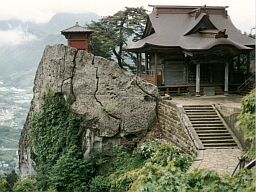 From Hokkaido I traveled back to Honshu and then to
the town of Akayu in the Yamagata ken. I spent several days visiting an English guy called
Peter, whom I had met whilst traveling in Indonesia. Peter was teaching English in Akayu
and while he was at work he lent me his car to explore the area. Over the few days I
visited the famous onsen and rotemburo at Mt. Zao and the temple of Yama-dera. To reach
the temple of Yama-dera I had to climb hundreds of steps up to it's cliff top location.
From the temple there were great panoramic views out over the surrounding countryside.
After Akayu I returned to Tokyo and spent a further week exploring the city and
socializing with Mark and his girlfriend Debbie.
From Hokkaido I traveled back to Honshu and then to
the town of Akayu in the Yamagata ken. I spent several days visiting an English guy called
Peter, whom I had met whilst traveling in Indonesia. Peter was teaching English in Akayu
and while he was at work he lent me his car to explore the area. Over the few days I
visited the famous onsen and rotemburo at Mt. Zao and the temple of Yama-dera. To reach
the temple of Yama-dera I had to climb hundreds of steps up to it's cliff top location.
From the temple there were great panoramic views out over the surrounding countryside.
After Akayu I returned to Tokyo and spent a further week exploring the city and
socializing with Mark and his girlfriend Debbie.
On 9th July, after exploring Japan for almost 2 months, I caught a direct flight across the Pacific to Vancouver in Canada. I was a little sad to be leaving Asia, but now I had the Americas to explore!